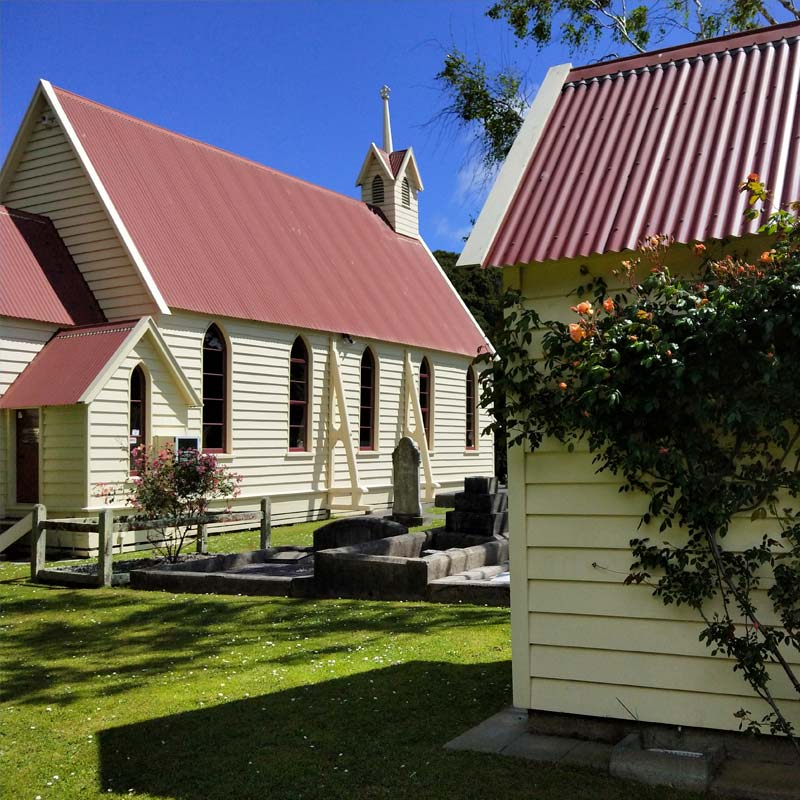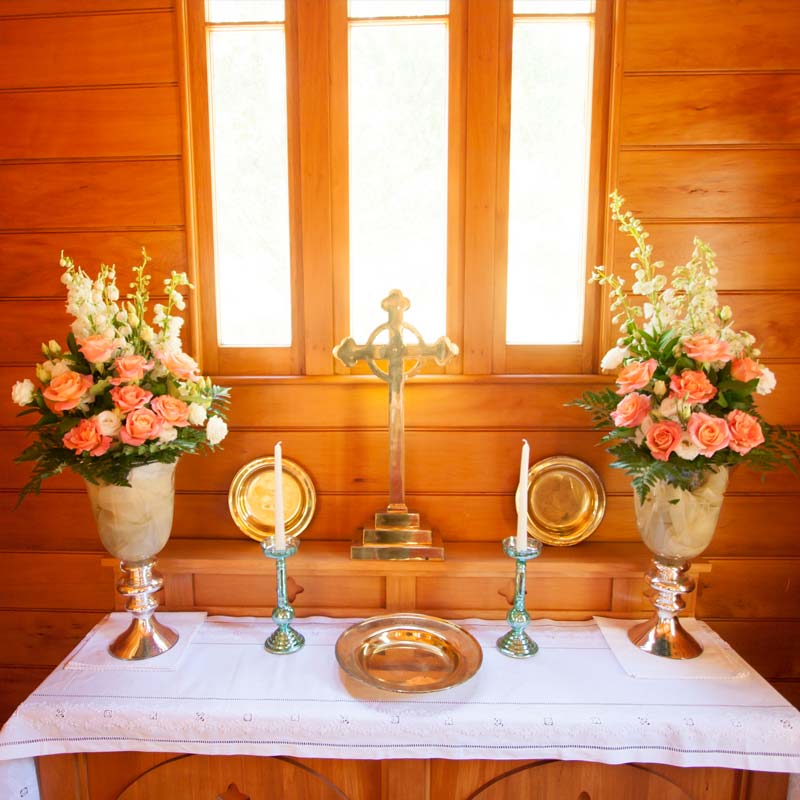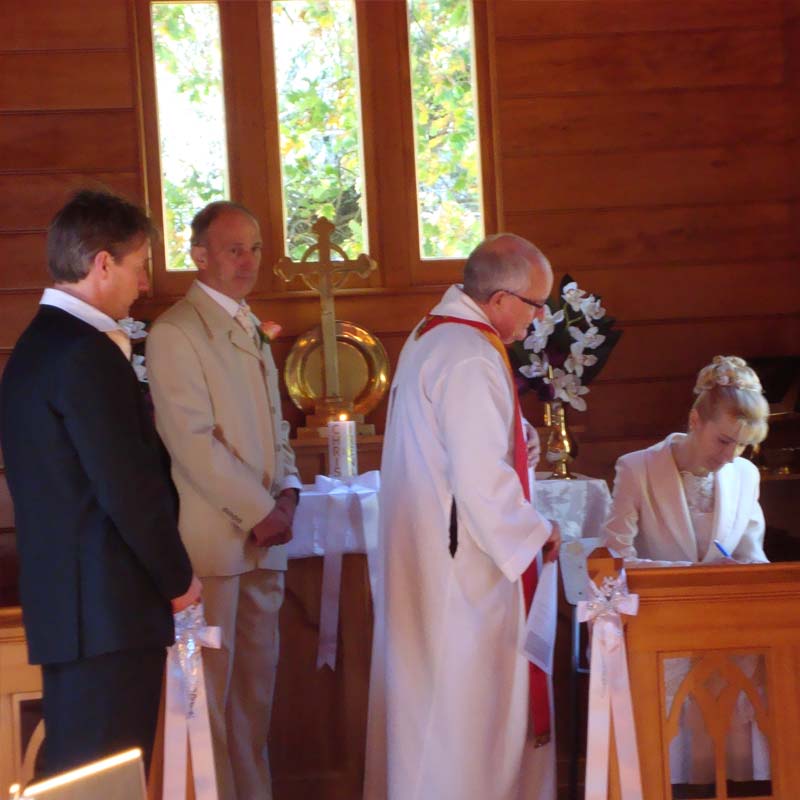Evening Post 5 November 1930
CHURCH JUBILEE
ST. JAMES”, LOWER HUTT
INTERESTING HISTORY
OLD-TIME CHARM
A church building should, by its general atmosphere, impart to the worshippers a feeling of calm restfulness and engender an attitude of mind which relegates material things to a secondary position. St. James” Anglican Church, Lower Hutt, fulfils that ideal, and follows the best traditions of the parish church of the Old Land. It would be hard to imagine Gray writing his elegy in the churchyard of a modern institutional church — it has indeed no yard at all, only a site generally covered with ugly buildings — but St James”, with its old-world setting, would gladden the heart of the poet.
Set well back from Woburn road, away from the rush of the hurrying motor traffic, embowered in stately trees, above which its spire points heavenward, surrounded by grassy lawns in which are to be seen the hallowed graves of those far-sighted pioneers who chose the site with such wisdom, stands the building which, for fifty years, has been the spiritual home of the members of the Church of England in Lower Hutt.
The jubilee services are to be conducted next Sunday by Canon Watson.
It should be noted, however, that the services commemorate merely the jubilee of the present building. The history of the Church of England in Lower Hutt is really the history of the British community in the district, for the first church came into being over ninety years ago. The exact site of this building, the name of its builder, and the name of the first person to preach the Gospel within its walls, are not on record. The site is now probably under water somewhere near the main bridge over the Hutt River. At this time the Hutt River could be crossed by a polejumper, and it is questionable if a bridge existed, for it is probable that the church was an earlier erection than even the quaint “willow pattern” footbridge which spanned the stream at this place. All that is known is that the church stood on the western bank near the site of the inn variously, known as “Burchams,” “The Aglionby Arms,” and “Valentines.” The erection of the building was probably a community effort, as its architecture and its materials were of the simplest, being after the style of a Maori whare and built of raupo. Its first minister was almost certain to have been the Rev. J. F. Churton, who, it is recorded, was in 1840 holding services in his own whare on the Pito-o-one beach. It is on record that a Rev. Mr. Butler was buried in the churchyard of this building, but what, his connection with the church was is not known.
Another name connected with the ministry in this building is that of the Rev. Robert Coles, who had charge of St. Paul”s in Wellington and ministered here on occasions.
In the old register of St. Paul”s may be seen the names of those baptised by the Rev. Mr. Coles in Aglionby-on-the-Hutt the name by which Lower Hutt was then known. Mr. Coles probably officiated after the departure of Mr. Churton, who stayed in the district for a short time only.
FIRST CHURCH WASHED AWAY.
This first church, with the bodies of those buried in its churchyard, was washed away by one of those tragic floods to which the Hutt River was subject, after it had served the community for a few years. Whether it survived the erection of its successor, which was really the first fully-organised Church of England in Lower Hutt, is not clear, but probably it had disappeared before the erection of the first traffic bridge in 1846-47. Some of the timber, the whole of the porch, and the windows of the second church are still in service, for the building was dismantled and re-erected in 1880, and now serves as the Sunday School.
The original building was erected by Messrs. J. H. Percy and Son in 1848, the date being fixed by the marriage certificate of Mr. Joseph Percy — the son in the firm of Percy and Son — who was married to Miss Anne Maria Welch on the church on 23rd October, 1848, while the shavings were still on the floor of the building.
Mr. Joseph Percy”s sons still occupy the same property — the old mill site — in Petone, while two other of the five families which then constituted Petone”s population are identified with the church.
Mr. Thomas Riddler claims to have been the first child baptised in this church. He is still living on his father”s property, and is hale and hearty at the age of 82.
The other family is the Collett family, of whom the late Mr. H. Collett and his son, the late Mr. Edward Collett, are both mentioned in the list of church officers.
After Mr. Churton”s departure the services were kept going by lay readers — notably by Mr. E. Davy. In 1848, the Rev. T. B. Hutton was appointed to the parish extending from Pencarrow Heads to Wairarapa. After ten years he was succeeded by the Rev. G. H. Johnstone, who was followed by the Rev. J. F. Herring.
In 1870 the Rev. Thomas Fancourt (afterwards Archdeacon of Wellington) was appointed, and it was during his ministry that the present church was built. The following account of its consecration is from the “Evening Post”:— St. James” Church.—” This church was consecrated by Bishop Hadfield on Sunday, 21st March, 1880. The weather was most inauspicious for the ceremony, the recent heavy rains having flooded the roads leading to the edifice. In spite of this drawback, a fairly large congregation attended to witness the consecration, which was carried out with the usual formalities. His Lordship was received at the main entrance by the minister and office-bearers, who presented a petition requesting the Bishop to open the church. A procession was then formed and proceeded up the middle aisle, the choir singing the 24th Psalm. On arriving at the Communion table the Bishop delivered an appropriate address, which was followed by prayer and the consecration sentences. The hymn, ”Holy, Holy, Holy,” was then sung, followed by the usual morning service. The sermon was preached by the Bishop from 1st Corinthians I., 25. The offertories were devoted to the building fund. The new church is an exceedingly pretty and commodious building, and presents a great contrast to the old church, which stands beside it.”
This building was erected by Mr. H. T. Beck, of Bridge street, Lower Hutt, who will be present at the jubilee services on Sunday. The contract price was £1400, and was, unfortunately, not a payable proposition. Originally there were four men interested in the contract, but before the work was completed the other three had dropped out and Mr. Beck was left to carry on. The timber, which was almost all totara, was all hand-dressed, and the gotliic window frames were cut out of solid timber. The architect was Mr. Thos. Turnbull, then Wellington”s leading architect. Tenders were called .in “The Evening Post,” and it was from this advertisement that Mr. Beck tendered.
Mr. Beck recalls that times were exceedingly bad at this period, and owing to competition a very low price was put in. Carpenters” wages then were 10s and labourers” 6s per day. Mr. Beck, who is now 77 years of ago, came to New Zealand 55 years ago under special engagement to assist in the erection of the big wooden Government Buildings in Wellington.
The names of the wardens and vestry in 1880 were, as follows: — Mr. W. A. Fitzherbert (vicar”s warden), Mr. J. R. Ransom (parishioners”), Captain Hewitt, Messrs. Cleland, Edward Collett, —. Williams, J. Wilkins, H. S. Fitzherbert, H. Collett, C. E. Barraud, and Captain Johnston. The descendants of many of these are well known, including the present Acting-Prime Minister.
In 1884 Mr. Fancourt, in order to devote more of his energies to the work of diocesan secretary, resigned, and was followed, for a very brief period, by the Rev. E. S. Cross, during whose ministry the present vicarage was built. Mr. Cross was succeeded by the Rev. Joshua Jones, well known to all old Hutt residents. During his term Petone — in 1895 — and later Eastbourne and the Eastern Bays separated from the Hutt church.
GREAT CHANGES.
After twenty-nine years of patient ministry Mr. Jones resigned, and soon afterwards passed to his rest. His successor, the present vicar, the Ven. A. L. Hansell (Archdeacon of Wairarapa), has seen great changes. The district has grown from a purely residential suburb, surrounded by farms, to a town of some 13,000 people. The church has been enlarged, and even now it is too small. A fine schoolroom has been put up and is in constant use. The policy of the vestry has been to take the Church to the people. In 1920 the Church of the Good Shepherd was opened at Epuni, where ground has been purchased for a future vicarage; in 1928 another churchroom (which at the present time is being enlarged) was opened at Waiwetu and dedicated to St. Paul. At both these new churchrooms, at the Parish Church, at Christ Church, Taita, and at Belmont, regular services are held by the archdeacon, his colleague, and a fine band of lay readers.
Though the present building is in a fair state of repair, it is recognised that its period of useful service is drawing to a close, and a fund has been inaugurated for a new building. Already a generous response has been made, and it is hoped that a very substantial sum will be forthcoming at the thanksgiving services on Sunday.
New Zealand Gazette and Wellington Spectator 26 June 1841
Died
It is our melancholy duty to record the death of the Rev. John Gare Butler, Native Guardian and Interpreter to the New Zealand Company, at 25 minutes past 2 o”clock in the afternoon of Friday, the 18th of June. The rev. gentleman suffered intensely during a period of twelve weeks, and leaves a numerous circle of friends to lament his loss. He was in his 60th year
New Zealand Spectator and Cook”s Strait Guardian 15 May 1852
On the 12th inst., in the valley of the Upper Hutt, Hannah, widow of the late Rev. John Butler, the resident Clergyman, in New Zealand, aged 76 years
=
New Zealand Gazette and Wellington Spectator 23 September 1843
Married
21st instant, at the Native Church Petoni, by Robert Cole, Clerk, M.A., Richard Barton, Esq., of Aglionby, on the Hutt, to Hannah only daughter of the Rev. John Butler, first resident clergyman in New Zealand, having commenced residence in the early part of 1819.
Wedding Venue Bookings
To book a wedding email
or phone Daphne Daysh 04 977 2055 or 027 687 2055



